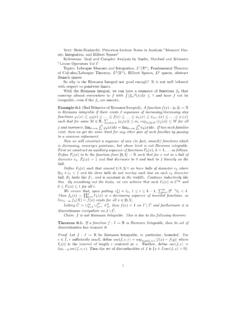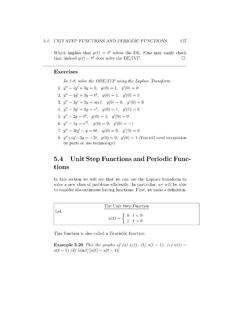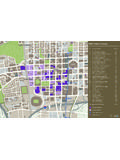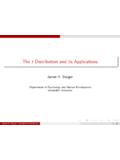Transcription of Green's Theorem and Parameterized Surfaces - Penn Math
1 green s Thm,ParameterizedSurfacesMath 240 green sTheoremCalculating areaParameterizedSurfacesNormal vectorsTangent planesGreen s Theorem and Parameterized SurfacesMath 240 Calculus IIIS ummer 2013, Session IITuesday, July 2, 2013 green s Thm,ParameterizedSurfacesMath 240 green sTheoremCalculating areaParameterizedSurfacesNormal vectorsTangent planesAgenda1. green s TheoremCalculating area2. Parameterized SurfacesTangent and normal vectorsTangent planesGreen s Thm,ParameterizedSurfacesMath 240 green sTheoremCalculating areaParameterizedSurfacesNormal vectorsTangent planesGreen s theoremTheoremLetDbe a closed, bounded region inR2whose boundaryC= Dconsists of finitely many simple, thatDis on the left as you traverseC. IfF=Mi+Njis aC1vector field onDthen CM dx+N dy= D( N x M y) : OSOcoll50424 ch06 PEAR591-ColleyJuly 28, 201120 s s TheoremGreen s Theorem relates thevector line integralaround a closed curveCinR2to an appropriatedouble integralover the plane regionDbounded byC.
2 Thefact that there is such an elegant connection between one- and two-dimensionalintegrals is at once surprising, satisfying, and powerful. green s Theorem , statedgenerally, is as follows: Theorem ( green STHEOREM)LetDbe a closed, bounded region inR2whose boundaryC= Dconsists of finitely many simple, closed, piecewiseC1curves. Orient the curves ofCso thatDis on the left as one traversesC. (SeeFigure ) LetF(x,y)=M(x,y)i+N(x,y)jbe a vector field of classC1throughoutD. Then CMdx+Ndy= D N x M y dx dy.(The symbol Cindicates that the line integral is taken over one or moreclosedcurves.)DC = DFigure shaded regionDhas a boundary consisting of twosimple, closed curves, each of classC1, whose union we 1 LetF=xyi+y2jand letDbe the first quadrant region boundedby the liney=xand the parabolay=x2.
3 We verify green s Theorem in this (1, 1)C1y = x2C2y = xDFigure regionDof Example regionDand its boundary are shown in Figure Dis orientedcounterclockwise, the orientation stipulated by the statement of green s calculate DF ds= Dxy dx+y2dy,we need to parametrize the twoC1pieces of Dseparately:C1: x=ty=t20 t 1 andC2: x=1 ty=1 t0 t 1.(Note the orientations ofC1andC2.) Hence, Dxy dx+y2dy= C1xy dx+y2dy+ C2xy dx+y2dy= 10 t t2+t4 2t dt+ 10((1 t)2+(1 t)2)( dt)= 10(t3+2t5)dt+ 102(1 t)2( dt)= 14t4+26t6 10+ 23(1 t)3 10=14+26 23= s Thm,ParameterizedSurfacesMath 240 green sTheoremCalculating areaParameterizedSurfacesNormal vectorsTangent planesExampleLetF=xyi+y2jand letDbe the first quadrant regionbounded by the liney=xand the parabolay=x2.
4 Let scalculate DF dsin two , we can calculate it Dusing two pieces:C1:{x=ty=t2andC2:{x= 1 ty= 1 twithtvarying from 0 to 1 for integral is DF ds= C1xy dx+y2dy+ C2xy dx+y2dy= 10(t3+ 2t5)dt+ 102(1 t)2( dt)= s Thm,ParameterizedSurfacesMath 240 green sTheoremCalculating areaParameterizedSurfacesNormal vectorsTangent planesExampleLetF=xyi+y2jand letDbe the first quadrant regionbounded by the liney=xand the parabolay=x2. Let scalculate DF dsin two ways. DF ds= C1xy dx+y2dy+ C2xy dx+y2dy= 10(t3+ 2t5)dt+ 102(1 t)2( dt) = , let s do the calculation using green s Theorem . DF ds= D[ xy2 y(xy)]dxdy= 10 xx2 xdy dx= 10x3 x2dx= s Thm,ParameterizedSurfacesMath 240 green sTheoremCalculating areaParameterizedSurfacesNormal vectorsTangent planesUsing green s Theorem to calculate areaRecall that, ifDis any plane region, thenArea ofD= , if we can find a vector field,F=Mi+Nj, such that N x M y= 1, then we can use DM dx+N dy= D( N x M y)dxdy= D1dxdy=area ofDto calculate the area ofDvia aline integral!}}
5 Here are three such (of many):F=xj,F= yi,orF=12( yi+xj). green s Thm,ParameterizedSurfacesMath 240 green sTheoremCalculating areaParameterizedSurfacesNormal vectorsTangent planesUsing green s Theorem to calculate areaTheoremSupposeDis a plane region to which green s Theorem appliesandF=Mi+Njis aC1vector field such that N x M yisidentically 1 onD. Then the area ofDis given by DF dswhere Dis oriented as in green s three examples from the previous slide yieldArea ofD= Dxdy D y dx D12( y dx+xdy). green s Thm,ParameterizedSurfacesMath 240 green sTheoremCalculating areaParameterizedSurfacesNormal vectorsTangent planesUsing green s Theorem to calculate areaExampleWe can calculate the area ofan ellipse using this : OSOcoll50424 ch06 PEAR591-ColleyJuly 26, 201113:31430 Chapter 6 Line IntegralsOn the other hand, D x(y2) y(xy) dx dy= 10 xx2 xdydx= 10 x(x x2)dx= 10(x3 x2)dx= 14x4 13x3 10=14 13= line integral and the double integral agree, just as green s Theorem says theymust.
6 XyaCDFigure disk ofradiusawith boundaryoriented so that green stheorem 2 Consider C ydx+xdy, whereCis the circle of radiusa( ,the boundary of the diskDof radiusa), oriented counterclockwise as shown inFigure Although we can readily parametrizeCand thus evaluate the lineintegral, let us employ green s Theorem instead: C ydx+xdy= D x(x) y( y) dx dy= D2dx dy=2(area ofD)=2 rightmost expression is twice the area of a disk of radiusa. In this case, thedouble integral is much easier to consider than the line integral. The use of green s Theorem in Example 2 can be put in a much more generalsetting: Indeed, ifDisanyregion to which green s Theorem can be applied, then,orienting Dappropriately, we have12 D ydx+xdy=12 D2dx dy=area ofD.
7 (1)Thus, we can calculate the area of a region (a two-dimensional notion) by usingline integrals (a one-dimensional construction)!xy(0, b)(a, 0)DFigure regioninside the ellipsex2/a2+y2/b2= 3 Using formula (1), we compute the area inside the ellipsex2/a2+y2/b2=1 (Figure ).The ellipse itself may be parametrized counterclockwise by x=acosty=bsint0 t 2 .Once again, using formula (1), we find that the area inside the ellipse is12 D ydx+xdy=12 2 0 bsint( asintdt)+acost(bcostdt)=12 2 0(absin2t+abcos2t)dt=12 2 0ab dt= ab. The ellipse can be parameterize byx(t) = (acost,bsint),with0 t 2 .Now our Theorem tells us that the area of the ellipse is12 x y dx+xdy=12 2 0(absin2t+abcos2t)dt=12 2 0abdt= s Thm,ParameterizedSurfacesMath 240 green sTheoremCalculating areaParameterizedSurfacesNormal vectorsTangent planesParameterized surfacesDefinitionLetDbe a plane region that consists of an open set togetherwith some or all of its boundary.
8 Aparameterized surfaceinR3is a continuous mapX:D R2 R3that is one-to-oneonD, except possible along is a subtle difference between the mapping,X, and itsimageX(D), which is just a set of refer toX(D)as theunderlying surfaceofX, or use bold letters ( ,Y) to representparameterizedsurfacesand unbold, upper-case letters ( ,T) to representtheunderlying s Thm,ParameterizedSurfacesMath 240 green sTheoremCalculating areaParameterizedSurfacesNormal vectorsTangent planesParameterized surfacesExamples1. The parameterizationX:R2 R3defined byX(s,t) =s(i j) +t(i+ 2k) + 3jdetermines a LetD= [0,2 ) [0, ]and considerX:D R3given byX(s,t) = (coss)(sint)i+ (sins)(sint)j+ (cost) The equations x= cossy= sinsz=t0 s 2 satisfyx2+y2= 1, so they parameterize a s Thm,ParameterizedSurfacesMath 240 green sTheoremCalculating areaParameterizedSurfacesNormal vectorsTangent planesTangent and normal vectorsDefinitionGiven a parameterizationX(s,t) = (x(s,t),y(s,t),z(s,t)),thetangent vector with respect tosisTs= X s= x si+ y sj+ z , thetangent vector with respect totisTt= X t= x ti+ y tj+ z normal vectorisN=Ts s Thm,ParameterizedSurfacesMath 240 green sTheoremCalculating areaParameterizedSurfacesNormal vectorsTangent planesTangent and normal vectorsExampleThe equationz2=x2+y2defines a cone can be Parameterized byX=s(cost)i+s(sint)]
9 J+sk,withtvarying from 0 to2 .We haveTs= (cost)i+ (sint)j+kandTt= s(sint)i+s(cost) ,N=Ts Tt= ijkcostsint1 ssint scost0 = s(cost)i s(sint)j+ s Thm,ParameterizedSurfacesMath 240 green sTheoremCalculating areaParameterizedSurfacesNormal vectorsTangent planesTangent planesDefinitionWe say that a Parameterized surface issmoothif theparameterization isC1and if it has a nonzero normal vector atevery a Parameterized surface smooth at the pointX(s0,t0). Thetangent planeto the surface Parameterized byXis the plane that passes throughX(s0,t0)and has normalvectorN(s0,t0).It is given by the equationN(s0,t0) (x X(s0,t0)) = (s0,t0) = (x0,y0,z0)andN(s0,t0) =Ai+Bj+Ckthenthe equation can also be writtenA(x x0) +B(y y0) +C(z z0) = s Thm,ParameterizedSurfacesMath 240 green sTheoremCalculating areaParameterizedSurfacesNormal vectorsTangent planesTangent planesExampleRecall the Parameterized coneX(s,t) =s(cost)i+s(sint)j+skfrom the previous the point(0,1,1) =X(1, 2),our previous calculation gives usTs= (0,1,1),Tt= ( 1,0,0),andN= (0, 1,1).
10 Hence, the equation for the tangent plane is0(x 0) 1(y 1) + 1(z 1) = 0,which simplifies toz=y.



















